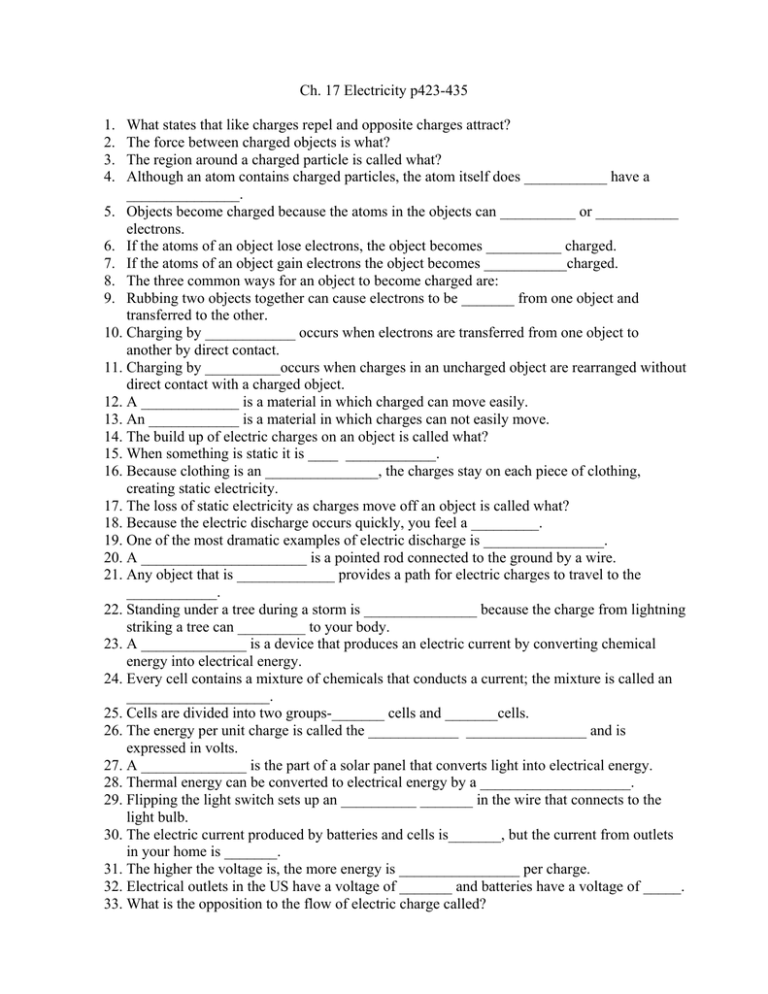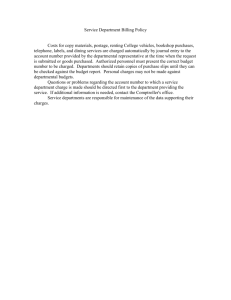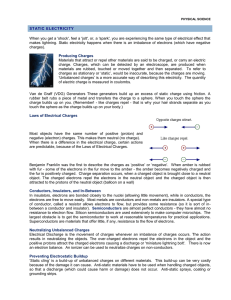Ch. 17 Electricity p423-435 1. What states that like charges repel
advertisement

Ch. 17 Electricity p423-435 1. 2. 3. 4. What states that like charges repel and opposite charges attract? The force between charged objects is what? The region around a charged particle is called what? Although an atom contains charged particles, the atom itself does ___________ have a _______________. 5. Objects become charged because the atoms in the objects can __________ or ___________ electrons. 6. If the atoms of an object lose electrons, the object becomes __________ charged. 7. If the atoms of an object gain electrons the object becomes ___________charged. 8. The three common ways for an object to become charged are: 9. Rubbing two objects together can cause electrons to be _______ from one object and transferred to the other. 10. Charging by ____________ occurs when electrons are transferred from one object to another by direct contact. 11. Charging by __________occurs when charges in an uncharged object are rearranged without direct contact with a charged object. 12. A _____________ is a material in which charged can move easily. 13. An ____________ is a material in which charges can not easily move. 14. The build up of electric charges on an object is called what? 15. When something is static it is ____ ____________. 16. Because clothing is an _______________, the charges stay on each piece of clothing, creating static electricity. 17. The loss of static electricity as charges move off an object is called what? 18. Because the electric discharge occurs quickly, you feel a _________. 19. One of the most dramatic examples of electric discharge is ________________. 20. A ______________________ is a pointed rod connected to the ground by a wire. 21. Any object that is _____________ provides a path for electric charges to travel to the ____________. 22. Standing under a tree during a storm is _______________ because the charge from lightning striking a tree can _________ to your body. 23. A ______________ is a device that produces an electric current by converting chemical energy into electrical energy. 24. Every cell contains a mixture of chemicals that conducts a current; the mixture is called an ___________________. 25. Cells are divided into two groups-_______ cells and _______cells. 26. The energy per unit charge is called the ____________ ________________ and is expressed in volts. 27. A ______________ is the part of a solar panel that converts light into electrical energy. 28. Thermal energy can be converted to electrical energy by a ____________________. 29. Flipping the light switch sets up an __________ _______ in the wire that connects to the light bulb. 30. The electric current produced by batteries and cells is_______, but the current from outlets in your home is _______. 31. The higher the voltage is, the more energy is ________________ per charge. 32. Electrical outlets in the US have a voltage of _______ and batteries have a voltage of _____. 33. What is the opposition to the flow of electric charge called?


